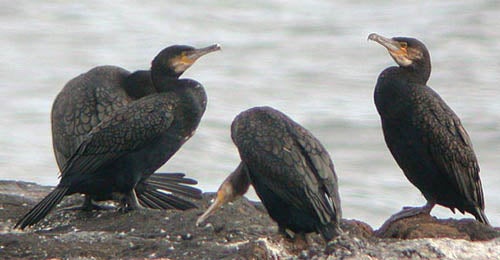SCIENTIFIC NAME:
Phalacrocorax carbo
OTHER NAMES:
Black cormorant, white breasted cormorant, common cormorant, black shag.
STATUS:
Occasional, mostly in fall and winter, on Gulf Coast.
DESCRIPTION:
Great cormorants belong to Order Pelecaniformes, as do a number of other primarily aquatic birds (anhingas, pelicans, boobies, and frigate birds). They are the largest members of the cormorant family, Phalacrocoracidae, averaging 35-40 inches long with wingspans which sometimes reach 5 feet. Adults usually weigh between five and six pounds with females slightly smaller than males. Immature birds are mostly brown with white on their bellies while the plumage of adults is largely glossy black. Adults have small white or yellowish patches on the chin and/or throat and, during the breeding season, males have white patches on each thigh.
Cormorants’ necks which feature small crests of black feathers may be flecked with white or grey. Their eyes are green and their long hooked grey bills may approach 4 inches in length. Cormorant’s feet are black.
DISTRIBUTION:
Great cormorants are a very widespread species. They are found in Africa, Europe, China, Japan, India, Southeast Asia, Papau New Guinea, Australia, New Zealand, Iceland, Greenland, and the eastern portions of North America.
HABITAT: Great cormorants are most common in temperate regions. They are most frequently found associated with habitats providing permanent fairly deep water (in which they feed) bordered by trees for roosting. Suitable habitats include the open sea and estuaries as well as freshwater rivers and lakes. They are frequently seen perched in trees, their wings widespread, allowing their feathers to dry.
FEEDING HABITS:
Great cormorants are effective aquatic predators, feeding on fish, crustaceans, squid, frogs, and various insect species. They are excellent swimmers and capture their food during relatively shallow underwater dives which may last up to a minute. Great cormorants swim underwater using their feet, but not their wings. While their preening glands do, in fact, produce oil, these birds coat their feathers only sparingly. It is believed that this less than complete waterproofing of their plumage improves their ability to swim underwater by reducing their buoyancy. Great cormorants have been observed swallowing pebbles prior to feeding, then regurgitating them afterward. The extra weight provided by these stones is believed to further aid their ability to dive.
In some parts of the world great cormorants are viewed as pests because they compete with people for food fish. Conversely, in parts of China they are raised, trained, and used by man to catch fish. Birds used for this purpose have rings placed around their necks which prevent them from completely swallowing their prey. Their handlers can then pry open their beaks, trigger a regurgitation reflex and retrieve the fish before sending them back out for another.
LIFE HISTORY AND ECOLOGY:
Great cormorants reach sexual maturity at about two years of age. Courtship begins with the male resting on the water. In an effort to attract a mate the male raises and lowers his long wings while holding his head and tail upright. This position exposes the white patches on his flanks. The upraised wings are vibrated rapidly. When a female approaches on the water, the male swings his head back and fourth, tail still raised, and calls loudly (‘kwer kwer’). The female, if sufficiently impressed, responds with a purring sound.
Great cormorants are highly social birds, especially during the breeding season. Some breeding takes place throughout the year, but most occurs during the spring. Most nesting takes place in colonies located on cliff ledges overlooking the sea or on rocky islands. Some nests are constructed in low trees that may eventually die as a result of the urea in the bird’s droppings. Colonies may include thousands of breeding pairs while numbers of other colonial water birds may be present as well.
Three or four chalky, pale blue-green eggs are laid (one every two or three days) in crudely built stick nests. These nests may be used for many years, not necessarily by the same pair, and may reach depths of more than three feet. Great cormorants are monogamous and both male and female share in nest building and in incubating the eggs for 27 to 31 days. During incubation, parents place their large webbed feet under the eggs with their warm bodies above.
Chicks, when hungry, peck at the parents’ throats. This causes the adults to regurgitate food for the chicks. When they are thirsty, chicks beg for water by silently holding their bills open with their heads held back. The parents then fill their own beaks with water and pour it into the chicks’ waiting mouths. Hatchlings fledge at about seven weeks of age, but are dependant on their parents for up to ten weeks.
REFERENCES:
Great Cormorant Phalacrocorax carbo. Zoological Parks and Gardens Board of Victoria 2004.
Submerged swimming of the great cormorant Phalacrocorax carbo sinensis is a variant of the burs and glide gait. Http://jeb.biologists.org/cgi/content/abstract/208/20/3835
AUTHOR:
John Powers, Wildlife Biologist, Alabama Division of Wildlife & Freshwater Fisheries






